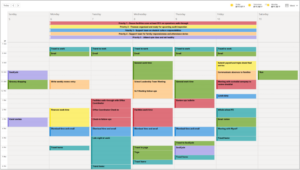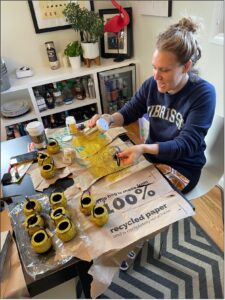Now I don’t mean to start a blog post with such a violent title, but notebooks are not as effective as we think they are. Why, you may ask, as you cling to your beautiful Moleskine black-bound notebook or your beloved spiral?
Why I Hate Notebooks for Organization:
(Disclaimer: I do like notebooks for journaling and brainstorming)
- Next steps get stuck in them. I conducted a very unscientific study and found that the fancier the notebook, the less likely the next steps emerge from its pages and get done in real life. Only very, very disciplined people can find time to review pages of old notes on a regular basis and actually DO something with them. I am not one of those people (and, no offense, there is a 99.99% chance that neither are you).
- They steal your power to sort and file. Notebooks are BOOKS, after all, and most people do not tear pages out. So, when you need those great ideas from a professional development session in 2008, you can’t even remember which notebook to start looking in!
- They become a disorganized jumbled mess that takes on a life of its own. Between your pages lie heaps of short-term to-do’s, ideas for next year, a scrawled phone number, some deadlines you heard announced at a staff meeting and a receipt for an item of clothing shoved in the back.
So, What’s Better Than a Notebook?
Two Choices:
- Take notes electronically. Kate, a third grade teacher, responsible for an upcoming field trip took careful notes at a recent grade team meeting. Note that she went into the meeting about an upcoming field trip with an electronic template ALREADY IN PLACE in an email draft so she could type her notes and next steps exactly where she needed them, rather than having to take word-for-word notes and sort them out later. You can find a copy of Kate’s template (Group Meeting Notes) here.

- Use loose sheets of paper to take notes.
This works well when for meetings and events when you cannot have a screen up. You might be surprised to hear that I, the Together Teacher Lady, would recommend LOOSE PAPER for teachers, people who are often *drowning* in paper. Here’s why:
Deb, a school-based speech pathologist with over ten years of experience, killed the notebook. She admitted, “Before using meeting note templates, I had notebooks all over the place. Some notebooks had PD notes, some had student observations, some had department meeting musings. I didn’t have a way to refer back to my notes in an organized way. In addition to my notebooks, I also took notes right on the meeting agendas, which were most often lost or never referred back to.”
Many teachers keep extra copies tucked in their Together Teacher systems (often a small binder), and the paper templates are ready to go if the situation requires them. You can find the templates Deb used here.
Both Kate and Deb took notes in a way that enabled them to quickly follow up on next steps from the meeting by:
- Clearly noting dates, participants, and purpose. This makes the notes searchable.
- Separated thoughts from her actions. This makes the notes actionable and shareable.
- Ensured her next steps were incredibly specific. This makes sure things happen.
So, after Kate and Deb take their notes, what do they actually DO with them?
- Review your notes at the end of the day or week. Kate can also easily email her team their next steps.
- Transfer next steps to their Weekly Worksheet, Comprehensive Calendar, or Upcoming To-Do List.
- For electronic meeting notes:Give electronic files very clear document names, e.g. ThirdGradeTeamMeeting_2012-05-25. This way, your file is easily searchable on your hard drive. Using this format means that an entire year of grade level meetings will organize themselves chronologically.
- For paper-based meeting notes:
My favorite option. . . Recycle!
Second favorite option. . . Scan notes using my favorite tool (below!) and label the document clearly on your hard drive as you would for electronic notes.

Together Teacher Reflection:
- How do you currently take notes? What’s working about your system? What’s not?
- Do you have a good electronic method and a good paper method?



